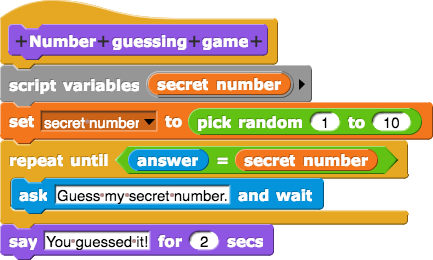-
Analyze and Debug. This definition for a
Number guessing gameblock has a bug—an error in the code that makes the program behave differently than expected. This code, if you keep playing over and over, will mostly work, but sometimes (not often) it will congratulate you before you even guess.
This is a kind of debugging strategy (perhaps: "narrowing the possibilities"?). Do we want to say anything more about it? --MF, 3/21/18If you build this to try it out, have it pick its random number just from 1 to 3 to make the bug occur more often.
 Analyze the code, or experiment with it, and explain how this can happen.
Analyze the code, or experiment with it, and explain how this can happen.
- If it isn't open already, open your U2L1-NumberGuessing project.
-
There are a few different ways to fix the bug.
At first, I wondered if this might be something that should be included in the debugging tip, but then I realized that I'm not sure what it means. Can someone who understands the intended meaning please look at this and explain it to me so we can work to clarify it? --MF, 3/21/18
After thinking about it yourself, see one way to do this.One way uses a second script variable to store and check the answer. You might find another way that you like better.If you want to add more script variables, use the right-pointing triangle. (The left triangle will remove them.)
Debugging Tip: Display of Variables
When you are debugging your code, it can help to see the value of a variable at different points in your program. There are several ways to do this:
- You can click the variable block (such as
 ) occasionally to report its current value.
) occasionally to report its current value. - If it's a global variable, you can mark the check-box beside it in the palette (
 ) to have a watcher display on the stage. (This also works for some reporters that aren't variables, as shown in the animation below.)
) to have a watcher display on the stage. (This also works for some reporters that aren't variables, as shown in the animation below.) - If it's a local (script) variable, you can use the
show variableblock to display a watcher on the stage (and usehide variableto hide it again). (This is also shown in the following animation.)
- You can click the variable block (such as
- Test and debug your code.